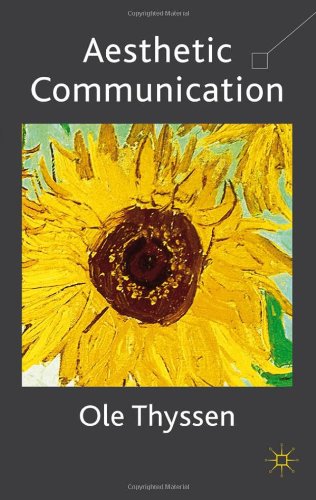

Most ebook files are in PDF format, so you can easily read them using various software such as Foxit Reader or directly on the Google Chrome browser.
Some ebook files are released by publishers in other formats such as .awz, .mobi, .epub, .fb2, etc. You may need to install specific software to read these formats on mobile/PC, such as Calibre.
Please read the tutorial at this link: https://ebookbell.com/faq
We offer FREE conversion to the popular formats you request; however, this may take some time. Therefore, right after payment, please email us, and we will try to provide the service as quickly as possible.
For some exceptional file formats or broken links (if any), please refrain from opening any disputes. Instead, email us first, and we will try to assist within a maximum of 6 hours.
EbookBell Team

4.7
66 reviews
ISBN 10: 0230245927
ISBN 13: 9780230245921
Author: O Thyssen
Introduction: Beyond Words—The Communicative Power of Aesthetics
1.1 Defining Aesthetic Communication: A Synthesis of Art, Sensation, and Meaning
1.2 The Limitations of Traditional Communication Models (Verbal, Linear)
1.3 Key Concepts: Sensibility, Form, Experience, and Affect
1.4 The Scope of the Book: From High Art to Everyday Life
1.5 A Road Map of the Chapters
Part I: Theoretical Foundations
Chapter 1: A Brief History of Aesthetics and Communication
2.1 From Ancient Greece to the Enlightenment: Beauty, Truth, and the Sublime
2.2 Kant and the Judgment of Taste: Disinterestedness and Universality
2.3 Romanticism and Expression: The Artist as Communicator
2.4 Walter Benjamin and the Age of Mechanical Reproduction: Aura and Authenticity
2.5 Modernism and Postmodernism: Form, Function, and the Fragmentation of Meaning
Chapter 2: Communication Theory and the Non-Verbal
3.1 Non-Verbal Communication: A Re-examination of Body Language, Space, and Time
3.2 Semiotics and Aesthetics: The Sign, the Symbol, and the Icon in Art
3.3 Phenomenology of Perception: Merleau-Ponty and the Embodied Experience of the Aesthetic
3.4 Affect Theory: The Transmission of Feeling and Mood through Form
3.5 The Role of Reception and Interpretation in Aesthetic Communication
Part II: Mediums and Modalities
Chapter 3: Visual Communication: Form, Color, and Image
4.1 The Language of Lines, Shapes, and Composition
4.2 Color Theory and its Emotional Impact
4.3 Photography and Film: The Aesthetic of the Frame and the Sequence
4.4 The Aesthetics of Urban Space: Architecture, Design, and Public Art
Chapter 4: Auditory Communication: Sound, Rhythm, and Silence
5.1 Music as a Universal Language? Transcending Words
5.2 The Aesthetic of Noise and Soundscapes
5.3 The Spoken Word as a Form of Aesthetic Communication (Poetry, Oratory)
5.4 Silence as a Communicative Element
Chapter 5: Performative Communication: Body, Movement, and Presence
6.1 Dance and Choreography: The Aesthetics of Kinesics
6.2 Rituals, Ceremonies, and Festivals as Aesthetic Communication
6.3 The Performativity of Identity: Dress, Style, and Self-Presentation
6.4 The Role of Spectatorship and Audience Participation
Chapter 6: Haptic and Olfactory Communication: Touch and Scent
7.1 The Aesthetics of Touch: Texture, Materiality, and Embodied Experience
7.2 The Communicative Power of Scent: Memory, Emotion, and Identity
7.3 The Aesthetics of Food and Taste: Communicating Culture through Cuisine
Part III: Contexts and Applications
Chapter 7: Aesthetics in the Marketplace: Brand Communication and Design
8.1 The Aesthetics of Consumer Culture: From Product Design to Advertising
8.2 Branding and Identity: The Communicative Power of Logos and Visual Identity
8.3 The Experience Economy: Designing Aesthetic Environments for Consumption
8.4 The Role of Aesthetics in Persuasion and Consumer Behavior
Chapter 8: Political Aesthetics: Propaganda, Protest, and Public Space
9.1 The Aesthetics of Power: Architecture, Monuments, and State Ceremonies
9.2 Visual Activism and Protest Art: Communicating Dissent
9.3 Propaganda and the Manipulation of Aesthetic Forms
9.4 The Aestheticization of Politics in the Digital Age
Chapter 9: The Everyday Aesthetics of Digital Communication
10.1 The Aesthetic of the Interface: UI/UX Design and User Experience
10.2 Social Media and the Performance of the Self: The Filter, the Image, and the Meme
10.3 The Aesthetics of Digital Sound and Video
10.4 The Future of Aesthetic Communication in the Age of AI
Conclusion: Towards a Comprehensive Theory of Aesthetic Communication
11.1 Synthesizing the Threads: From Intersubjectivity to Affective Resonance
11.2 The Ethical and Political Dimensions of Aesthetic Communication
11.3 Future Research Trajectories
11.4 A Final Reflection on Art, Life, and Communication
aesthetic communication
example of aesthetic communication
common modes of aesthetic communication
aesthetic communication theory
aesthetic communication theory in translation
Tags: O Thyssen, Aesthetic, Communication